|
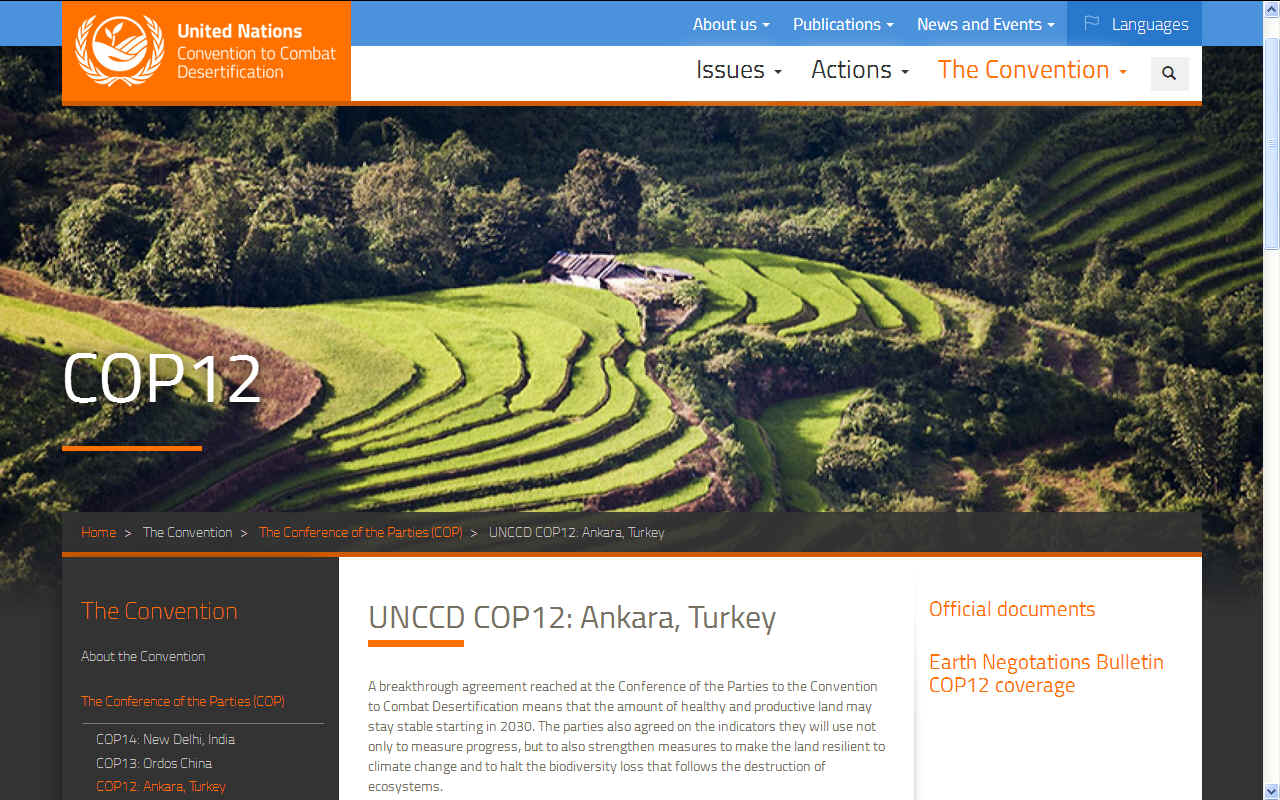
COP12 - In
2015
the Convention Conference was hosted by Turkey, a country that is arid
and under a great deal of financial pressure with austerity measures in
place to appease the European Union. Turkey is a moderate user of coal,
oil, diesel
and petroleum fossil
fuels compared to China and the USA. It is the burning of these
fuels that creates greenhouse gases
such as carbon
dioxide and nitrous
oxide, the accumulation of which are causing global
warming that is changing our climate to makes deserts of land that
was previously arable.
The
twelfth Conference of the Parties to combat desertification was held in
Ankara, Turkey from the 12th to the 23rd October 2015.
A breakthrough agreement reached at the Conference of the Parties to the Convention to Combat Desertification means that the amount of healthy and productive land may stay stable starting in 2030. The parties also agreed on the indicators they will use not only to measure progress, but to also strengthen measures to make the land resilient to
climate change and to halt the biodiversity loss that follows the destruction of ecosystems.
With the adoption of the land degradation neutrality target, “all countries will now formulate voluntary targets to achieve LDN according to their specific national circumstances and development priorities... The indicators will provide the basis for the monitoring and evaluation approach to assess implementation. The same indicators could guide the synergy Parties have always called for among the three Rio Conventions – desertification, climate change and biodiversity,” said Ms Monique Barbut, Executive Secretary of the
Desertification Convention.
Like the queen in a chess game, she said, “land will fill a place as the
Queen of both international development and climate change actions. Unlike other pieces on the board, the Queen provides cover and supports our ambitions on many fronts; food, energy, water, climate, biodiversity, jobs, migration and security.”
“For a very long time, we have left the land – our Queen – vulnerable…. But you have made some strategic moves at this COP. There was no check-mate here. But by adopting Land Degradation Neutrality as an organizing principle, you have given us a clear game-plan and vision and direction for the future. For the next 15 years,” Ms Barbut said.
The agreement follows the adoption of the Global Goals for Sustainable Development in New York last month. The Conference in Ankara was responding to a key target for 2030, which is to combat desertification, and restore degraded land and soil, including land affected by desertification, drought and floods, and strive to achieve a land-degradation neutral world.
The Parties meeting in Ankara agreed on the scientific definition of what it means to become land degradation neutral. She said after Parties have set their targets, they “will recover the land they use for purposes such as road and city construction and lose through degradation.”
Ms. Barbut said the decision puts the Desertification Convention on par with the Climate Change and Biodiversity Conventions, both of which have their own targets.
They also agreed on the set of land-based indicators that they will use to measure progress, which they are also recommending for adoption as the primary measures of land degradation neutrality globally. Ms. Barbut said there is “work to be done to ensure these indicators are workable and appropriate.”
Ms. Barbut stated that the Ankara Initiative valued at US$5million from Turkey and an estimated US$3 million to be sourced from the Global Environment Facility will provide the initial support, including for target setting.
An estimated US$2billion will be needed every year to support the actual restoration activities. This could be mobilized through the Land Degradation Neutrality Fund that will be operation by end of 2016, and with diverse sources of financing, including from the private sector, Ms. Barbut added.
Mr. Lütfü Akça, Under Secretary-General, Ministry of Forestry and
Water Affairs, underlined the endorsement of the land degradation neutrality target in the Ankara Ministerial Declaration, signaling the global nature of the target. He said the declarations by Parliamentarians, the private sector and the civil society organizations would enhance action, for instance, on early warning systems for drought, land rights and investment.
He said Turkey, as COP12 President, will present the Conference outcomes to the Paris 2015 Climate Conference taking place in December. He said the Ankara Initiative will be negotiated bilaterally with the Convention and will mainly support activities related to implementing the target on land degradation neutrality.
Underlining the significance of the COP12 achievements, Ms. Barbut said the reports from the Climate Change process show that “we are more at a 3 degrees Celsius than 2 degrees. If we want to stay within 2 degrees, we must massively invest in sequestration; and we could, in 15 years, halve the emissions gap” by making soil
carbon sequestration part of the Paris deal.
The Conference, which was the twelfth session of the Parties took place in Ankara, Turkey, from 12-23 October, and concluded on minutes to midnight on Friday night, 23 October. More than 6,000 delegates attended the session, including more than 75 high ranking delegates who attended the high level session, which was officially opened by Turkey’s President Recep Tayyip Erdogan.
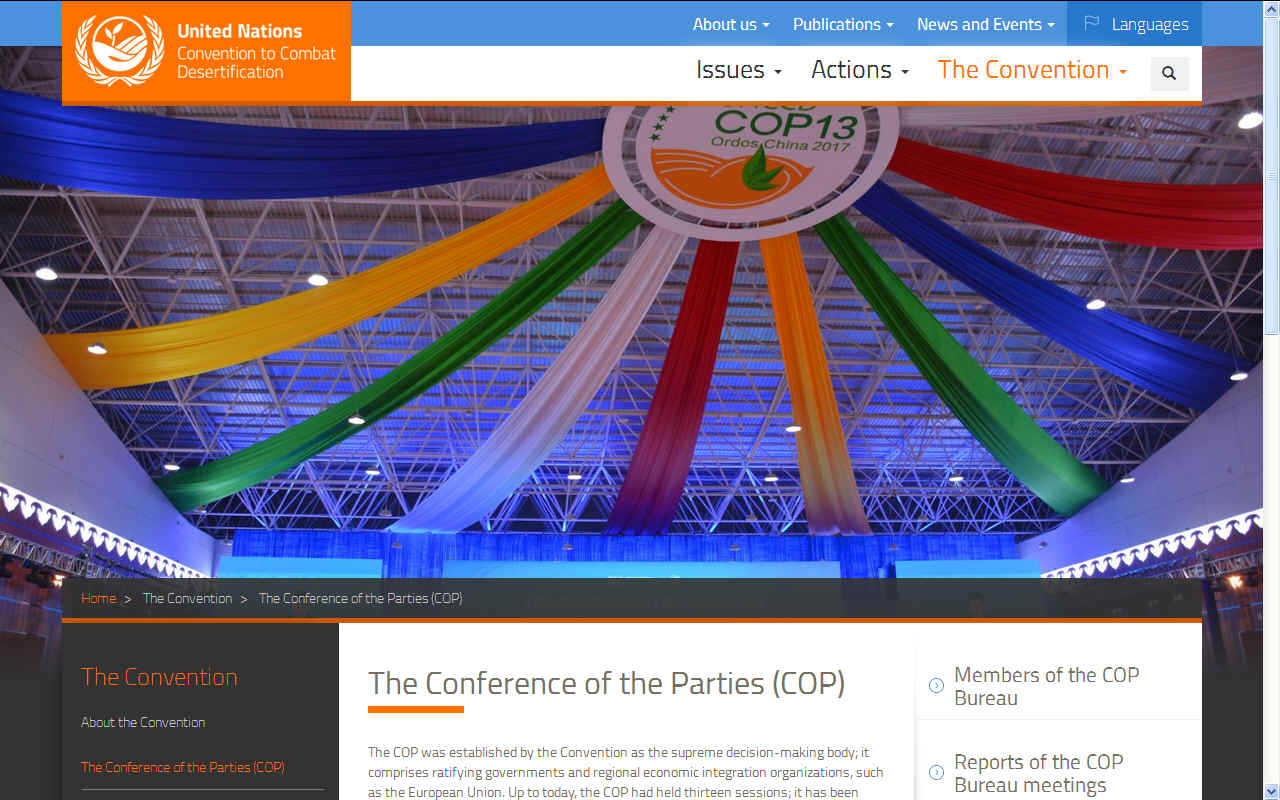
CHINA
2017 - In 2017
the Conference of the Parties (COP) was held in China.
This Conference witnessed the birth of the first global private sector fund dedicated to implementing the
SDGs, known as the Land Degradation Neutrality Fund.
WHAT
IS THE CONVENTION TO COMBAT DESERTIFICATION
The
United Nations Convention to Combat Desertification
is an agreement to hold meetings to decide how best to help countries
experiencing serious drought and/or desertification, particularly in Africa.
The UNCCD is a convention to combat
soil degradation that makes deserts of previously fertile land that have
been farmed out.
The aim
of the convention is to mitigate the effects of drought through national action programs that incorporate long-term strategies supported by international cooperation and partnership arrangements.
Sadly, climate change is causing a regular loss of land for use in
agriculture as global warming accelerates unchecked. That coupled with
intensive farming practices that are not sustainable, has created a
situation where people have become refugees as victims of developed
countries and their use continued use of fossil
fuels that create greenhouse
gases.
197
PARTIES
The Convention’s 197 parties work together to improve the living conditions for people in drylands, to maintain and restore land and soil productivity, and to mitigate the effects of drought.
Though given that climate change is uncontrolled, this is a losing
battle at best and very poor compensation to those who the developed
world are displacing.
The UNCCD secretariat facilitates cooperation between developed and developing countries, particularly around knowledge and technology transfer for sustainable land management.
That is a way of saying they are doing what they can, where they should
be dealing with the root cause.
The UNCCD collaborates closely with the other two Rio Conventions; the Convention on Biological Diversity (CBD) and the
United Nations Framework Convention on
Climate Change (UNFCCC),
to meet these complex challenges with an integrated approach and the best possible use of natural resources.
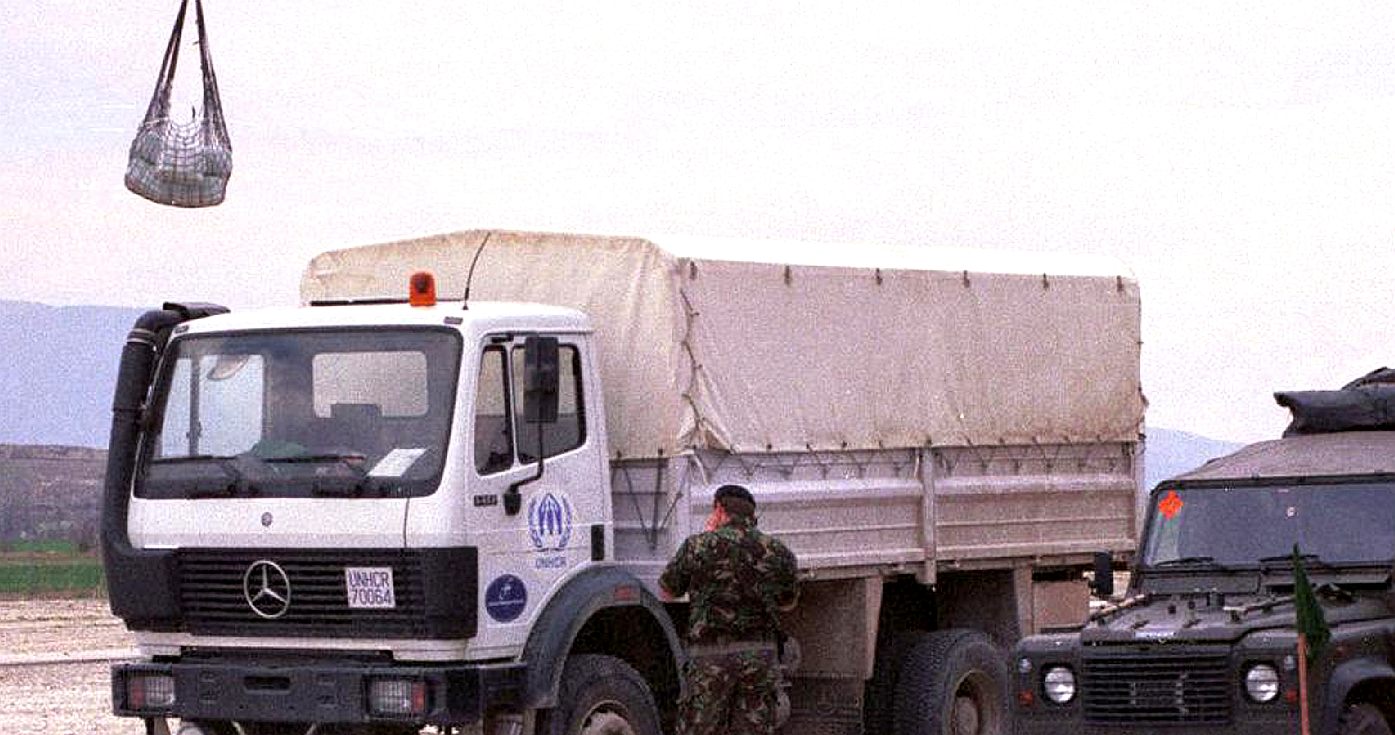
FOOD
AID -
Desertification gives rise to mass human migration as climate change
causes soil degradation, creating refugees who will need feeding as a result of the
fossil fuel excesses of the
developed world.
THE
REGIONS
Five
world regions – Africa, Asia, Latin America and the Caribbean (LAC),
Northern Mediterranean, Central and Eastern Europe - have the important
job of deciding how to implement the United
Nations Convention to Combat Desertification (UNCCD). The Convention
Text includes five annexes, which each concern one of these world
regions.
The
implementation of the UNCCD is organized around these five regional
implementation annexes. The annexes specify how the Convention will be
implemented for each region and set the focus and content of regional
and subregional action programmes. These action programmes provide a
framework for regional coordination and collaboration. Though the
country Parties of the regions define together how the UNCCD will be
implemented, most action takes place at the national level.
DESERTIFICATION COP HISTORY
|
COP 1: Rome, Italy, 29
Sept to 10 Oct 1997
|
COP 9: Buenos Aires,
Argentina, 21 Sept to 2 Oct 2009
|
|
COP 2: Dakar,
Senegal, 30
Nov to 11 Dec 1998
|
COP 10: Changwon, South
Korea, 10 to 20
Oct 2011
|
|
COP 3: Recife, Brazil, 15 to 26
Nov 1999
|
COP 11: Windhoek,
Namibia, 16 to 27
Sept 2013
|
|
COP 4: Bonn, Germany, 11 to 22
Dec 2000
|
COP 12: Ankara, Turkey, 12 to 23
Oct 2015
|
|
COP 5: Geneva,
Switzerland, 1 to 12
Oct 2001
|
COP 13: Ordos City,
China, 6 to 16
Sept 2017
|
|
COP 6: Havana, Cuba, 25 August to 5
Sept 2003
|
COP 14: New Delhi, India, 2 to 13
Sept 2019
|
|
COP 7: Nairobi, Kenya, 17 to 28
Oct 2005
|
COP 15: 2020
|
|
COP 8: Madrid, Spain, 3 to 14
Sept 2007
|
COP 16: 2021
|
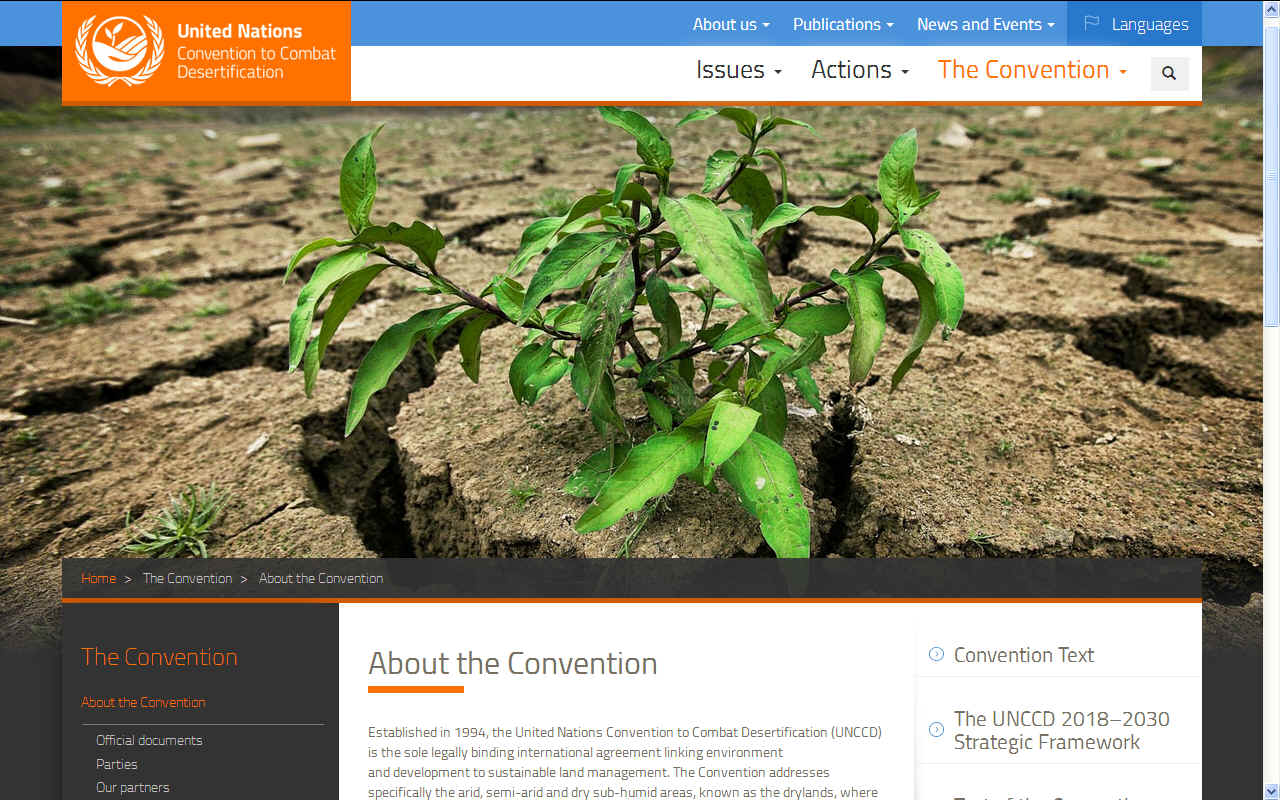
SOIL
EROSION - Desertification is a type of land degradation in which a relatively dry area of land becomes a desert, typically losing its bodies of water as well as vegetation and wildlife. It is caused by a variety of factors, such as through climate change (particularly the current global warming) and through the overexploitation of soil through human activity. When deserts appear automatically over the natural course of a planet's life cycle, then it can be called a natural phenomenon; however, when deserts emerge due to the rampant and unchecked depletion of nutrients in soil that are essential for it to remain arable, then a virtual "soil death" can be spoken of, which traces its cause back to human overexploitation. Desertification is a significant global ecological and environmental problem with far reaching consequences on socio-economic and political conditions.
The
more land that we lose for to grow crops the greater the food security
issue. The more ice that melts from global warming, the more our sea
level rises, again, reducing land area. World
politics is not working or we would not have these problems. We need
to change policies urgently to make politics work for the planet. If
that means electing new representatives and executive officers free from
conflicts of interest, who understand the urgency of sustainable
agriculture, low
carbon houses, renewable
energy and transport,
the electorate should give consideration to voting out the old and
voting in new blood for change.
CLIMATE CHANGE COP HISTORY
|
1995
COP 1, BERLIN, GERMANY |
2008
COP 14/CMP 4, POZNAN, POLAND
|
|
1996
COP 2, GENEVA, SWITZERLAND |
2009
COP 15/CMP 5, COPENHAGEN, DENMARK
|
|
1997
COP 3, KYOTO, JAPAN |
2010
COP 16/CMP 6, CANCUN, MEXICO
|
|
1998
COP 4, BUENOS AIRES, ARGENTINA |
2011
COP 17/CMP 7, DURBAN, SOUTH AFRICA
|
|
1999
COP 5, BONN, GERMANY |
2012
COP 18/CMP 8, DOHA, QATAR
|
|
2000:COP
6, THE HAGUE, NETHERLANDS |
2013
COP 19/CMP 9, WARSAW, POLAND
|
|
2001
COP 7, MARRAKECH, MOROCCO |
2014
COP 20/CMP 10, LIMA, PERU
|
|
2002
COP 8, NEW DELHI, INDIA |
2015
COP 21/CMP 11, Paris, France
|
|
2003
COP 9, MILAN, ITALY |
2016
COP 22/CMP 12/CMA 1, Marrakech, Morocco
|
|
2004
COP 10, BUENOS AIRES, ARGENTINA |
2017
COP 23/CMP 13/CMA 2, Bonn, Germany
|
|
2005
COP 11/CMP 1, MONTREAL, CANADA |
2018
COP 24/CMP 14/CMA 3, Katowice, Poland
|
|
2006
COP 12/CMP 2, NAIROBI, KENYA |
2019
COP 25/CMP 15/CMA 4, Santiago, Chile
|
|
2007
COP 13/CMP 3, BALI, INDONESIA |
2020
COP 26/CMP 16/CMA 5, to be announced
|
BIODIVERSITY
COP HISTORY
|
COP
1: 1994 Nassau,
Bahamas, Nov & Dec
|
COP
8: 2006
Curitiba, Brazil, 8 Mar
|
|
COP
2: 1995
Jakarta, Indonesia, Nov
|
COP
9: 2008 Bonn,
Germany, May
|
|
COP
3: 1996 Buenos
Aires, Argentina, Nov
|
COP
10: 2010
Nagoya, Japan, Oct
|
|
COP
4: 1998
Bratislava, Slovakia, May
|
COP
11: 2012
Hyderabad, India
|
|
EXCOP:
1999 Cartagena, Colombia, Feb
|
COP
12: 2014
Pyeongchang, Republic of Korea, Oct
|
|
COP
5: 2000
Nairobi, Kenya, May
|
COP
13: 2016
Cancun, Mexico, 2 to 17 Dec
|
|
COP
6: 2002 The
Hague, Netherlands, April
|
COP
14: 2018
Sharm El-Sheikh, Egypt, 17 to 29 Nov
|
|
COP
7: 2004 Kuala
Lumpur, Malaysia, Feb
|
COP
15: 2020 Kunming, Yunnan, China
|
UNCCD
CONTACTS
Postal Address
UNITED NATIONS
Convention to Combat Desertification
UNCCD Secretariat
P.O. Box 260129
D-53153 Bonn, Germany
Switchboard
Tel: +49-228 / 815-2800
Fax: +49-228 / 815-2898/99
Email: secretariat@unccd.int
Office
UNCCD
Platz der Vereinten Nationen 1
D-53113 Bonn, Germany
CSO Contact
Marcos Montoiro
NGO and Civil Society Liaison Officer
FCMI - Facilitation, Capacity Building and Monitoring of Implementation unit
United Nations Convention to Combat Desertification Secretariat
e-mail : CSO@unccd.int
T +49-228 / 815-2806
F +49-228 / 815-2898/99
CST contact
Co-ordinator STI Unit
T +49-228 / 815-2834
F +49-228 / 815-2898/99
E kmst@unccd.int
Press Office
T +49-228 / 815-2820
F +49-228 / 815-2898/99
E press@unccd.int
Librarian
Ms Katya Arapnakova
T +49-228 / 815-2864
F +49-228 / 815-2898/99
E library@unccd.int
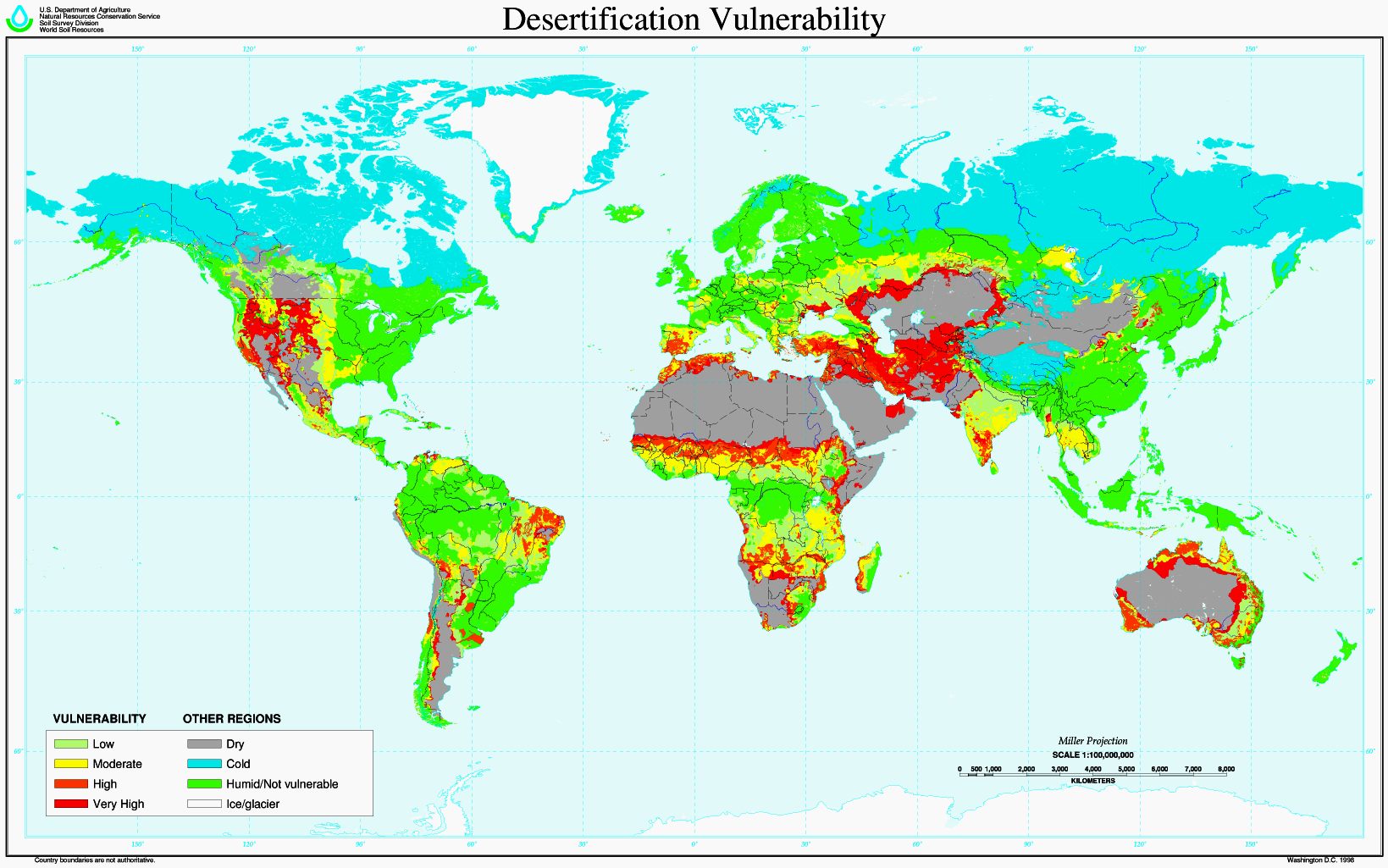
WORLD
MAP - Showing the vulnerability of regions to desertification by
colour code from blue (no risk) through to red (high risk) areas.
| ____ |
__ |
 |
LINKS
& REFERENCE
https://www.unccd.int/convention/conference-parties-cop/unccd-cop12-ankara-turkey
https://www.unccd.int/
https://www.unccd.int/convention/about-convention
https://www.un.org/
Please use our A-Z
INDEX to navigate this
site
|





